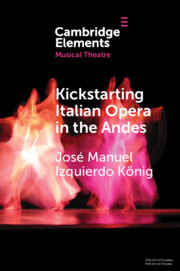26 results
Chapter 3 - Augustus Hardin Beaumont, Slavery Apologias, and Popular Radical Literature in the 1830s
-
-
- Book:
- Nineteenth-Century Literature in Transition: The 1830s
- Published online:
- 30 May 2024
- Print publication:
- 06 June 2024, pp 62-83
-
- Chapter
- Export citation
1 - Trans/Atlantic Origin Stories
- from The Sexuality of American History
-
-
- Book:
- The Cambridge History of Queer American Literature
- Published online:
- 17 May 2024
- Print publication:
- 06 June 2024, pp 33-54
-
- Chapter
- Export citation
Chapter 6 - The Polite Fictions of Slavery
-
-
- Book:
- Nineteenth-Century Literature in Transition: The 1830s
- Published online:
- 30 May 2024
- Print publication:
- 06 June 2024, pp 127-146
-
- Chapter
- Export citation
Chapter 8 - Italy in Transition
-
-
- Book:
- Nineteenth-Century Literature in Transition: The 1860s
- Published online:
- 01 February 2024
- Print publication:
- 08 February 2024, pp 147-165
-
- Chapter
- Export citation
Transatlanticism: A fading paradigm?
-
- Article
-
- You have access
- Open access
- HTML
- Export citation
“Junge Mädchen” and “Daughters of the Sky”: Transatlantic Changes in the Construction of Femininity after 1930
-
- Journal:
- Central European History / Volume 57 / Issue 1 / March 2024
- Published online by Cambridge University Press:
- 20 December 2023, pp. 44-58
- Print publication:
- March 2024
-
- Article
-
- You have access
- Open access
- HTML
- Export citation
Reflection: Firms, Rules, and Global Capitalism
-
- Journal:
- Business History Review / Volume 97 / Issue 3 / Autumn 2023
- Published online by Cambridge University Press:
- 03 January 2024, pp. 633-644
- Print publication:
- Autumn 2023
-
- Article
- Export citation
2 - Conceptual Approaches to Data Protection in the European Union and the United States
-
- Book:
- Transatlantic Jurisdictional Conflicts in Data Protection Law
- Published online:
- 06 April 2023
- Print publication:
- 13 April 2023, pp 18-32
-
- Chapter
- Export citation
3 - Imperial Designs and Regional Systems
- from Part I - Building the Mexican-Caribbean World
-
- Book:
- Veracruz and the Caribbean in the Seventeenth Century
- Published online:
- 19 January 2023
- Print publication:
- 19 January 2023, pp 74-105
-
- Chapter
- Export citation

Kickstarting Italian Opera in the Andes
- The 1840s and the First Opera Companies
-
- Published online:
- 07 January 2023
- Print publication:
- 26 January 2023
-
- Element
- Export citation
Chapter 8 - Abolition
- from Part I - Fractures and Continuities
-
-
- Book:
- American Literature in Transition, 1820–1860
- Published online:
- 09 June 2022
- Print publication:
- 23 June 2022, pp 120-144
-
- Chapter
- Export citation
Chapter 3 - National Correspondences
-
- Book:
- Mediating Cultural Memory in Britain and Ireland
- Published online:
- 10 March 2022
- Print publication:
- 17 March 2022, pp 108-156
-
- Chapter
- Export citation
Chapter One - After America
-
- Book:
- The Irish Expatriate Novel in Late Capitalist Globalization
- Published online:
- 29 October 2021
- Print publication:
- 11 November 2021, pp 29-83
-
- Chapter
- Export citation
Chapter 5 - Trees
-
- Book:
- Walter Scott and the Greening of Scotland
- Published online:
- 30 July 2021
- Print publication:
- 12 August 2021, pp 113-139
-
- Chapter
- Export citation
Chapter 2 - The British Isles
- from Part I - Places
-
-
- Book:
- Frederick Douglass in Context
- Published online:
- 16 June 2021
- Print publication:
- 08 July 2021, pp 21-33
-
- Chapter
- Export citation
Chapter 12 - Antislavery Activist Networks and Transatlantic Texts
- from Part III - Black Geographies in Transition
-
-
- Book:
- African American Literature in Transition, 1850–1865
- Published online:
- 07 April 2021
- Print publication:
- 13 May 2021, pp 307-330
-
- Chapter
- Export citation
10 - Transatlantic Modernity and Native Performance
- from Part II - Assimilation and Modernity (1879–1967)
-
-
- Book:
- The Cambridge History of Native American Literature
- Published online:
- 18 September 2020
- Print publication:
- 17 September 2020, pp 182-196
-
- Chapter
- Export citation
Introduction
-
- Book:
- Advocates of Freedom
- Published online:
- 07 September 2020
- Print publication:
- 17 September 2020, pp 1-47
-
- Chapter
- Export citation
9 - The Return of the Habanera: Carmen’s Early Reception in Latin America
- from Part II - Across Frontiers
-
-
- Book:
- <I>Carmen</I> Abroad
- Published online:
- 18 September 2020
- Print publication:
- 30 July 2020, pp 143-157
-
- Chapter
- Export citation
2 - Global Contexts: How External Factors Drive US Perceptions of Slavery
-
- Book:
- American Slavery, American Imperialism
- Published online:
- 17 August 2020
- Print publication:
- 30 July 2020, pp 67-106
-
- Chapter
- Export citation



